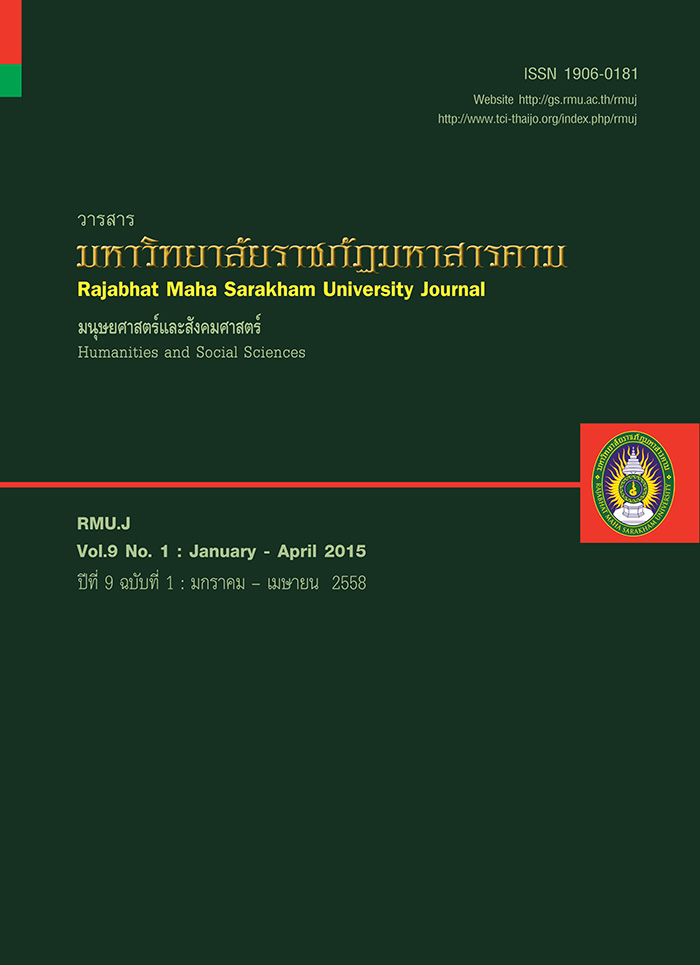ผลการเรียนด้วยบทเรียนบนเว็บแบบผสมผสาน 2 รูปแบบ เรื่อง โครงงานคอมพิวเตอร์ ที่มีต่อผลสัมฤทธิ์ทางการเรียน การคิดวิจารณญาณ และความคงทนในการเรียนรู้ ของนักเรียนชั้นมัธยมศึกษาปีที่ 6 ที่มีการนำตนเองในการเรียนรู้ต่างกัน;Effects of Learning the Topic of Computer
Main Article Content
บทคัดย่อ
การวิจัยครั้งนี้มีวัตถุประสงค์เพื่อพัฒนาบทเรียนบนเว็บแบบผสมผสาน 2 รูปแบบ เรื่อง โครงงานคอมพิวเตอร์ ที่มีประสิทธิภาพ
80/80 และเพื่อประเมินผลการใช้บทเรียนบนเว็บแบบผสมผสาน 2 รูปแบบกลุ่มตัวอย่างเป็นนักเรียนชั้นมัธยมศึกษาปีที่ 6 ภาคเรียนที่
2 ปีการศึกษา 2556 โรงเรียนบดินทรเดชา(สิงห์ สิงหเสนี) 4 จำนวน 62 คน จำนวน 2 ห้อง ซึ่งได้มาจากการสุ่มแบบกลุ่มโดยการจับ
สลาก เครื่องมือที่ใช้ในการวิจัยครั้งนี้ประกอบด้วย (1) บทเรียนบนเว็บแบบผสมผสาน แบบ 75 : 25 และแบบ 25 : 75 (2) แบบวัดผล
สัมฤทธิ์ทางการเรียน จำนวน 40 ข้อ และ (3) แบบทดสอบวัดความสามารถในการคิดวิจารณญาณ จำนวน 60 (4) แบบวัดคุณลักษณะ
การนำตนเองในการเรียนรู้ จำนวน 40 ข้อ (5) แบบวัดความพึงพอใจต่อบทเรียนบนเว็บแบบผสมผสาน จำนวน 20 ข้อสถิติที่ใช้ในการ
วิเคราะห์ข้อมูล ได้แก่ ร้อยละ ค่าเฉลี่ย ส่วนเบี่ยงเบนมาตรฐาน Dependent Samples t-test, F-test (Two-way MANCOVA,
Two-way ANCOVA และ Two-way ANOVA) ผลการวิจัยพบว่า
บทเรียนบนเว็บแบบผสมผสาน แบบ 75 : 25 และแบบ 25 : 75 มีประสิทธิภาพเท่ากับ 80.85/81.92 และ 81.02/82.27
ตามลำดับ และมีค่าดัชนีประสิทธิผลเท่ากับ 0.7007 และ 0.7101 ตามลำดับ นักเรียนโดยรวมและจำแนกตามการนำตนเองในการเรียน
รู้ที่เรียนด้วยบทเรียนบนเว็บแบบผสมผสานทั้ง 2 รูปแบบ มีผลสัมฤทธิ์ทางการเรียน และมีการคิดวิจารณญาณโดยรวมและเป็นราย
ด้านเพิ่มขึ้นจากก่อนเรียน (P ≤ .001)นอกจากนี้ นักเรียนที่มีการนำตนเองในการเรียนรู้ต่างกัน และนักเรียนที่เรียนด้วยรูปแบบ
การเรียนต่างกันมีผลสัมฤทธิ์ทางการเรียน การคิดวิจารณญาณ และความคงทนในการเรียนรู้ไม่แตกต่างกัน และไม่มีปฏิสัมพันธ์ระหว่าง
การนำตนเองในการเรียนรู้ และรูปแบบการเรียนต่อผลสัมฤทธิ์ทางการเรียน การคิดวิจารณญาณ และความคงทนในการเรียนรู้ของ
นักเรียน นอกจากนี้นักเรียนมีความพึงพอใจต่อการเรียนอยู่ในระดับมากถึงมากที่สุด
This research aimed to develop lessons on two types of blended web on the topic of the Computer
Project with an efficiency of 80:80, and to evaluate the developed blended web-lessons.Sixty-two
Mathayomsuksa VI students attending the Bodindecha (Sing Singhasene) 4 School in the second semester
of the academic year 2013, were selected as a sample group, using the cluster random sampling technique.
Research instruments included (1) two lessons on two types of blended web: 75 : 25 model , and 25 : 75
model; (2) the learning achievement test with 40 items; and (3) a critical thinking test with 60 items; (4) Selfdirected
learning questionnaire with 40 items ; and (5) the questionnaire on satisfaction on blended web -
learning with 20 items. The data were analyzed using percentage,mean, standard deviation,dependent t-test
and F-test (Two-way MANCOVA, Two-way ANCOVA and Two-way ANOVA).
The findings revealed that the blended web lessons with 75 : 25 model and 25 : 75 model had efficiencies
of 80.85/81.92 and 81.02/82.27respectively; and had efficiency indices of 0.7007 and 0.7101 respectively.
The students who learned through using two models of the blended weblessons showed gains in learning
achievement and critical thinking in overall and in each aspect (P ≤.001). In addition, the students with
difference in self- directed learning who learned through using two models of the blended web lessons had
no statistical differences in learning achievement, critical thinking and, learning retention. Statistical interactions
of self- directed learning and types of blended web lessons on learning achievement, critical thinking and
learning retention were not found to be significant. The students showed satisfaction on learning through the
two models at high to highest level.
Article Details
1. บทความที่ลงตีพิมพ์ทุกเรื่องได้รับการตรวจทางวิชาการโดยผู้ประเมินอิสระ ผู้ทรงคุณวุฒิ (Peer Review) สาขาที่เกี่ยวข้อง อย่างน้อย 3 ท่าน ในรูปแบบ Double blind review
2. ข้อคิดเห็นใด ๆ ของบทความที่ลงตีพิมพ์ในวารสารมหาวิทยาลัยราชภัฏมหาสารคาม นี้เป็นของผู้เขียน คณะผู้จัดทำวารสารไม่จำเป็นต้องเห็นด้วย
3. กองบรรณาธิการวารสารมหาวิทยาลัยราชภัฏมหาสารคาม ไม่สงวนสิทธิ์การคัดลอกแต่ให้อ้างอิงแสดงที่มา

